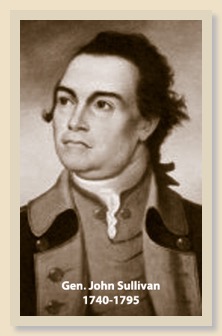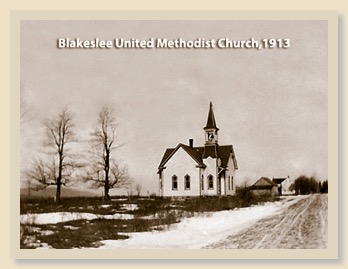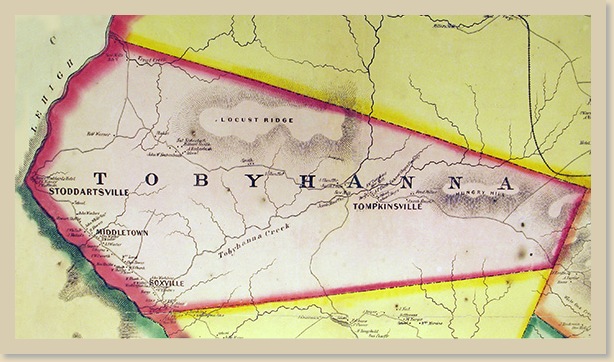THE HISTORY OF TOBYHANNA TOWNSHIP
This is an historical snapshot of Tobyhanna Township, Pennsylvania. Extended details and studies of this content will be updated on this website to document and preserve our rich history.From our first settlers to our schools and churches, from our first industries to our resorts, we provide this brief walk through the Township’s history.
Tobyhanna Township Comes Alive
The name of Tobyhanna Township was taken from the major stream running through it, Tobyhanna Creek, which feeds into the Lehigh River. Tobyhanna is of American Indian origins, interpreted as “a stream (bank) lined (fringed) with alders.” Alder is a common name associated with the birch tree family.
Settlers did live in and migrate in and out of the area before 1800, but they were few and inconsistent in residency. The population of the Township in 1830 was 274 residents. By 1860, the census recorded a total of 518. Little growth occurred in the second half of the century, with the 1880 census reporting less than 900 residents, and dipping to 654 at the turn of the century.
Remarkably, by 1960 the Township was still sparsely populated with a census of just over 1,800 residents. But by the year 2000, favorable economic conditions and social desires for open spaces and clean air saw the population explode to a census count of 6,152. Most certainly, the newer major highways of Interstate 80, Interstate 380 and the Pennsylvania Turnpike significantly facilitated this growth. This trend continues, with the 2010 census reporting 8,554 residents.
Of the 20 incorporated townships and boroughs in Monroe County, Tobyhanna Township now ranks #8 in residents. These statistics exclude the tremendous, welcomed immigration that occurs during the summer by property owners and vacationers who are not residents locally.
In 1800 and for the next 15 years, the base of the first permanent, long-term settlers is evidenced by the names of Leonard Stoddart, George Sox, William Hessler, Ezra Hays, Andrew Eschenbach, Jacob Blakeslee, Ira Winters and Robert Newell.
In 1830 Tobyhanna Township was created from Pocono Township when the area was part of Northampton County. In 1836 when Monroe County was formed, Tobyhanna Township was one of the original townships received from Northampton County. In 1843 the western section of the Township was spun off, contributing to the formation of Carbon County. Division again occurred in 1856 as Tunkhannock Township was formed from the southern portion of Tobyhanna Township.
By 1845, 30 sawmills existed, and all developed property had an assessed value of $13,150, with trade and occupations being assessed in total of $950.
Early Development
The Township is located on top of the Pocono Plateau with its elevation approaching 2,000 feet, where winters are longer and harsher. The Wisconsinan Glacier, the last glacier in North America, terminated at the southern side of the Township over 10 million years ago. The forces of this advancement and retraction created many swamps and boreal bog areas, making it tough to navigate through the countryside. Thick forests of pine, hemlock, spruce, oak, cherry and mountain laurel complicated access for early settlers. Until 1779, travel was restricted to virtually the use of foot and deer paths through the region.
But there were early settlers, attracted by the wealth of natural resources and expanses of high quality land. In 1769, a land dispute between Pennsylvania and Connecticut erupted into the Pennamite-Yankee War in Northeast Pennsylvania, as far south as Locust Ridge in the Township. Here, a battle ensued, resulting in injury with at least one mortally wounded combatant. A gravesite is preserved in the Locust Ridge area.

But there was no road “over the mountain.” Sullivan’s engineers first had to build that road, which today is known as the Sullivan Trail. It crested the mountain and wound its way through marshes, over streams and through thick forest, with the building army suffering injury, hunger and even death along the way. A significant memorial is today maintained on Sullivan Trail near Route 940, commemorating this struggle and achievement, where an unknown soldier is buried. Thousands of troops, wagons, canon, horses, cattle and supplies moved their way through Tobyhanna Township, over the Tobyhanna Creek that is today Pocono Lake, north over Locust Hill (Ridge) and northwest to the Wyoming Valley. This resulted in a viable road for settlers, trappers and traders to develop the Township.
Due to the density and high quality of forests, lumbering became the early, significant economic activity in the Township. Virgin forests were cut for many purposes — building materials, ship building and leather tanning, being primary. Wooden clothes pin and shoe peg manufacturing flourished, as well as the production of roof shingles and barrel staves. Forest products such as Christmas trees and greens for wreaths and decorative ropes were exported to the cities.

In 1803, a major roadway through the township was commissioned, known as the Easton Wilkes-Barre Turnpike, serving those two population centers. Lord Butler served as its president. Completed by 1815, it opened the western portion of the Township to development, for towns such as Soxville, Middletown (later Blakeslee area) and Stoddartsville.

As a canal was proposed for the Lehigh, Stoddart placed his investment risk in the building of the canal through his area. But that never happened, causing him and the town’s operations financial bankruptcy. But in spite of that misfortune, western Tobyhanna Township was now open to the world. It was a significant part of the Township’s history, as proven by the Stoddartsville Historic District being placed on the National Register of Historic Places in 1998, through the efforts of John Lord Butler.
During the mid to late 1800s the central and eastern sections of the township also developed around the lumber industry, with sawmills and lumber operations in Houser’s Mills, today named Pocono Lake and Tompkinsville, later named Naomi Pines and today Pocono Pines.
Residents of Tobyhanna Township have been supportive of our freedom, by serving our community and our country, from the Pennamite-Yankee War starting in 1769 through to combat and support operations in the Iraqi and Afghanistan wars. All veterans are our favorite sons and daughters, but one in particular has a special position in history. Pvt. William Henry Christman of the Pocono Lake area of Tobyhanna Township was the first soldier to be buried in the new Arlington National Cemetery on May 13, 1864.
Our Growth
In 1857, progress arrived in the Township in the form of a major railroad, the Delaware, Lackawanna & Western Railroad. With a freight and passenger station built in Pocono Summit, transportation for both incoming and outgoing freight as well as significant passenger service was in place. Although the station was technically in Coolbaugh Township by a block or two from Tobyhanna Township, it nevertheless became the rail service for Tobyhanna Township, accessing the major markets of New Jersey, New York City and Scranton.

There was also a large inspection and maintenance shop operation located in the vicinity of today’s Four Corners (intersection of Sullivan Trail and Long Pond Road), known as Little Summit. Coal was king, and both railroads’ primary revenue was from that product. But other freight was important, hauling ice, lumber, blueberries, produce, milk, mail and all other essentials.
And passenger service grew as the resort industry blossomed in the Township. The D, L & W RR successor is still in business today as a short line railroad, transporting grain that originates from the fields of Canada to the large flour mill operations in Pocono Summit. The Pocono Summit station still stands but has been closed for many years. The WB&E succumbed to acquisitions and competition, declaring bankruptcy in 1937 and closure in 1939. All stations and rails were subsequently dismantled and sold.
Next to lumber, the selling of ice became one of the most important exports of the Township in the later part of the 1800s and the early 1900s. With the population growth in the metro New York and Philadelphia regions, and the need for refrigeration to preserve food in its distribution and restaurant and home storage, the demand for ice continually increased. The winters in the Township provided for an annual environment in which ice of substance would form on lakes, being available for removal.
But few natural lakes existed, so man intervened. Man-made lakes were built for this purpose — Stillwater Lake, Naomi Lake (Lake Naomi), enlargement of Pocono Lake and Anglewood Lake. Enormous ice houses were built to store the winter harvest, packed in sawdust from the saw mills, for shipment by rail car to the cities in warmer weather. Both railroads built rail sidings to most of these ice houses, as it was welcomed business for the railroads. This industry provided significant employment to Township residents until electricity and the popularity of electric refrigerators started to take hold in the 1920s and 1930s.
Open for Business
As the railroads opened access to the world, the world now had access to the Poconos and Tobyhanna Township. Growth of cities, and the desire to escape the crowded and hot conditions of the summer, created another industry for Tobyhanna Township. The resort industry for summer holidays and vacations blossomed with the railroads as the birth of the automobile continued the need for development of our roads.

Summer camps for children abounded, such as the three large compounds in Lutherland, and the camps of Owaissa and Pine Tree. The Boy Scouts built Camp Minsi around Stillwater Lake and it is quite active to present day. The post World War II era saw the Township develop into a four-season resort destination, with the development of ski resorts and communities such as Lake Naomi, Arrowhead Lake, Stillwater Lake, Pinecrest, Wagner’s Forest and others.
Further resort, recreational and retreat facilities were developed on an even larger scale, with the development of the Pocono Pines Assembly in 1903. A large multi-facility complex in Naomi Pines, it was devoted to the religious, cultural and educational “Chautauqua Movement.” In 1926 it was purchased by a group associated with the Lutheran Church and was greatly expanded into “Lutherland,” serving thousands each year.
Also developed in the early 1900s, the large natural and secluded Pocono Lake Preserve continues a healthy but intentionally secluded and private society within the Township today.
As folks were finding more time for family recreation, Harrison Park just south of Blakeslee offered first-rate amusement park rides and picnicking facilities, and today is a splendid preserve along Tobyhanna Creek known as the Austin T. Blakeslee Natural Area. An airport developed in Blakeslee and in use for a number of years provided initial exposure to the area, and with the subsequent building of Interstate 80 providing access, Blakeslee has been developing as a gateway to the Township and major, nearby ski and golf resorts.
Our People
Of course, the Township could not exist today without the historical fabric of its schools, churches, library and families.

The evolution of our school system was, and still is, grassroots, with the first being built in the Blakeslee area in 1831. More schools were built by the community in Blakeslee, Locust Ridge and Pocono Pines in the 1800s, providing a future for the Township’s children.
And the Clymer Library, having roots starting in 1902, has evolved and grown over the years as a first class repository with superb educational and service support to the Township.
The enthusiasm and pride of Tobyhanna Township has been a constant source of the Township’s success. Too many to mention, but just a few by example that made this all possible, are the Tobyhanna Township families of Stoddart, Sax, Blakeslee, Eschenbach, Winters, Kerrick, Miller, Keiper, Stauffer, Winter, Tompkin, Hays, Bonser, and Henning. These, and many others, have provided us with a legacy that transcends the generations and has positioned our future as a vibrant community.
Welcome to the rich history of Tobyhanna Township.
Rick Bodenschatz
Gene Kerrick
Kim Kerrick
Fred Lehrer
Ted Suttmeier
